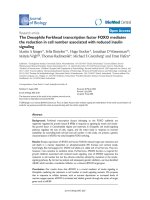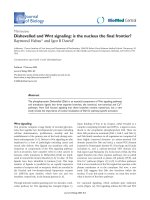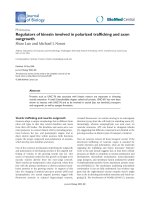Báo cáo sinh học: "Dishevelled nuclear shuttling" potx
Bạn đang xem bản rút gọn của tài liệu. Xem và tải ngay bản đầy đủ của tài liệu tại đây (78.77 KB, 4 trang )
A classical way to investigate the func-
tions of a protein is to start by defining
where it is distributed. Membrane-span-
ning proteins often function as receptors
involved in recognition and cell adhe-
sion, whereas nuclear proteins fre-
quently play a role in regulating gene
expression and transcription. But it is
becoming increasingly clear that protein
subcellular localization can be extremely
dynamic, allowing key proteins to play
different roles in different compart-
ments. Now, in Journal of Biology [1],
Sergei Sokol and colleagues show that
the Dishevelled (Dsh) protein of the
Wnt signaling pathway can shuttle in
and out of the nucleus (see ‘The bottom
line’ box for a summary of the work and
‘Background’ for further explanations
and definitions). These observations
challenge the conventional thinking
about Dsh function and suggest that
Dsh might do very different things
depending on where it is in the cell.
Canonical and non-canonical
Wnt pathways
During growth, development and
disease, extracellular signals are commu-
nicated, or transduced, into the cell and
in such a way as to elicit a particular
cellular response. Many key signal trans-
duction pathways have been dissected
using genetic and biochemical
approaches; such studies have defined
the molecules that ensure signals initi-
ated at the cell surface are efficiently
transmitted to the cell nucleus, where
they often result in the induction of a
specific gene-expression program.
Many signal transduction pathways are
composed of modules that are remark-
ably conserved across species, such
that lessons from different experimen-
tal model organisms have contributed
to the understanding of molecular
hierarchies that control signal communi-
cation in many cellular contexts.
Studies of the Wnt pathway provide
a wonderful example of how
researchers from different fields have
contributed to a detailed understand-
ing of a key signal transduction
pathway [2]. The Wnt pathway is criti-
cal for development and homeostasis
of animals from Hydra to human [3];
Wnt signaling regulates cell prolifera-
tion, cell polarity and cell-fate determi-
nation. The Wnt signaling machinery
is tightly regulated, and disruption of
components of the signaling pathway
have been implicated in diseases
including cancer [2,4].
Research news
Dishevelled nuclear shuttling
Jonathan B Weitzman
BioMed Central
Journal
of Biology
Structure-function analysis of the Dishevelled (Dsh) protein in frog embryos has defined
sequences that regulate Dsh nuclear localization, which proves critical for Wnt signaling.
Published: 16 February 2005
Journal of Biology 2005, 4:1
The electronic version of this article is the
complete one and can be found online at
/>© 2005 BioMed Central Ltd
Journal of Biology 2005, 4:1
The bottom line
•
Sokol and colleagues found that the Dishevelled (Dsh) protein of the Wnt
signaling pathway is found in the cell nucleus in response to Wnt signaling.
• Mutation of a nuclear export signal in Dsh leads to accumulation of Dsh in
the nucleus but does not impair canonical Wnt signaling.
• Mutation of the nuclear localization signal (NLS) in Dsh disrupts the
protein’s ability to activate downstream target genes; this activity can be
restored by replacement of the relevant sequence with an unrelated NLS.
• Nuclear localization of Dsh appears to be essential for its function in the
canonical Wnt--catenin signaling pathway.
The first step in the Wnt signal
occurs when extracellular Wnt ligand
binds Frizzled receptors on the cell
surface, leading to the activation of
several distinct transduction pathways
(see Figure 1). The canonical Wnt
pathway involves stabilization of the
intracellular protein

-catenin. The
degradation of -catenin is regulated
by interaction with a number of pro-
teins including Axin, glycogen syn-
thase kinase 3 (GSK3) and the
adenomatous polyposis coli protein
(APC). The degradation machinery is
inhibited by Dsh, leading to the accu-
mulation of -catenin, which in turn
translocates to the nucleus and initi-
ates a gene expression program by
interacting with transcription factors
such as T-cell-specific transcription
factor (TCF). Frizzled receptors can
also initiate an independent ‘non-
canonical’ Wnt pathway that diverges
to regulate complex developmental
events involved in planar cell polarity
and convergent extension movements
during embryo development, via small
GTPases and the JNK kinase. The intra-
cellular protein Dishevelled is common
to both canonical and non-canonical
signaling pathways, raising the ques-
tion of how this mysterious protein
acts at the signal crossroads.
Dishevelled distribution
The Dishevelled protein was first dis-
covered in flies, and several homologs
have been found in other organisms
including mammals [3]. Analysis of
Dsh sequence alignments revealed the
presence of three conserved domains
called DIX, PDZ and DEP [5,6], which
are implicated in protein-protein inter-
actions and targeting to subcellular
sites. The modular design of the Dsh
protein suggested that different
domains might function to route Wnt-
Frizzled signals in different directions.
Sokol’s group at Harvard Medical
School decided to test this hypothesis by
making mutant forms of Dsh that lack
different domains and fusing them to
green fluorescent protein (GFP) to track
their subcellular localization (see the
‘Behind the scenes’ box for more of the
rationale for the work). When they
expressed the full-length Dsh-GFP
protein in Xenopus ectoderm cells they
observed spotty staining in the cyto-
plasm, but a Dsh protein lacking the
DEP domain appeared in the nucleus.
Initially perplexed, Sokol and colleagues
then scanned the Dsh polypeptide for a
leucine-rich nuclear export sequence
(NES). They found one and mutated it
to demonstrate that normally Dsh is
efficiently exported from the nucleus by
means of this sequence. The NES
mutant accumulated in the nucleus, but
it could still function normally, induc-
ing a secondary dorsal axis when
injected into frog embryos (a classical
developmental assay for Dsh biological
activity). The team confirmed the
nuclear shuttling of Dsh using drugs that
block active nuclear export; these drugs
led to nuclear accumulation of endoge-
nous Dsh proteins in mammalian cells.
“Once we had seen nuclear export
we wanted to find out if there was an
import signal,” recalls Sokol. His team
hunted for a conventional nuclear
localization signal (NLS). “This was
probably the most difficult part of the
study, because the Dsh NLS doesn’t
match the known consensus.” The
team began a mutagenesis program,
hacking away at the protein until they
narrowed the NLS down to a short
stretch of residues between the PDZ
and DEP domains. “The Dsh NLS is
1.2 Journal of Biology 2005, Volume 4, Article 1 Weitzman />Journal of Biology 2005, 4:1
Background
•
The Dishevelled (Dsh) gene was first identified in Drosophila by the
description of a mutant with defects in the arrangement of bristles on the
wing and thorax. Dsh mutant phenotypes are reminiscent of wingless and
armadillo mutant embryos; Wingless is the fly equivalent of mammalian Wnt
proteins and armadillo encodes the fly

-catenin protein.
• Secreted Wnt proteins associate with members of the Frizzled family of
seven transmembrane-domain receptors on the cell surface. Wnt binding
induces the phosphorylation of Dsh protein; Dsh can block the activity of
Axin, a cellular inhibitor of the Wnt signaling pathway (see Figure 1).
• Wnt signaling is implicated in many biological processes including cell
proliferation, cell polarity and cell-fate specification. The ‘canonical’
Wnt/

-catenin signaling pathway links Wnt signaling to stabilization of
the -catenin protein; -catenin in turn translocates to the nucleus and
interacts with T cell-specific transcription factor (TCF) to drive the
expression of target genes. Wnt signaling can also lead to activation of at
least one non-canonical pathway involved in regulating planar cell polarity.
• Dsh is composed of three conserved domains: the amino-terminal DIX
domain, which is found in Dsh and Axin; the central PDZ domain (found
in Postsynaptic density-95, Discs-large and Zonula occludens-1 proteins);
and the DEP domain (found in Dsh, Egl-10 and pleckstrin).
• The dynamics of protein localization inside the cell can be influenced by the
activity of nuclear localization signals (NLS) and nuclear export
signals (NES) that regulate protein shuttling into and out of the nucleus,
respectively.
atypical; it doesn’t look like anything
else,” comments Sokol. “But it’s very
conserved between Dsh proteins across
species, so it may be a specialized way
for Dsh to get into the nucleus.”
Removing the NLS blocked nuclear
import. NLS-mutant proteins also
failed to induce secondary axes in frog
embryos, or to stabilize -catenin and
activate downstream target genes.
When the Dsh NLS was replaced with
an unrelated NLS from a viral protein,
Dsh activity was restored, as was
canonical Wnt signaling. In contrast,
the Dsh NLS mutation did not affect
non-canonical Wnt signaling. Finally,
Sokol’s group showed that endogenous
Dsh relocates to the nucleus in mam-
malian cells upon Wnt stimulation.
Dishevelled’s nuclear shuffle
Sokol notes that some early reports
mentioned nuclear localization of Dsh
[7,8], but these did not address the
functional importance of Dsh nuclear
accumulation in Wnt signaling.
Randall Moon’s group at the Univer-
sity of Washington in Seattle had
noticed Dsh in the nucleus in associa-
tion with the Dapper protein [8].
“What is interesting is the Sokol
finding that blocking nuclear export
leads to accumulation in the nucleus,
suggesting that Dsh nuclear accumula-
tion is regulated,” says Moon. “This is
a careful study which provides com-
pelling evidence for Dsh nuclear
import,” adds Howard Hughes Investi-
gator Norbert Perrimon, who (inde-
pendent from Sokol) works at Harvard
Medical School.
“These results bring a new level of
complexity to the regulation of the
Wnt signaling pathway,” agrees Patri-
cia Salinas from University College
London, UK. Her group previously
showed that Dsh binds to micro-
tubules and locally regulates signaling
events in neuronal axons [9]. She notes
that a large number of Wnt signaling
components have recently been found
in the nucleus. “These results fit very
well with our view that Dsh regulates
distinct signaling events in specific cel-
lular compartments. Our task now is
to elucidate how the localization of
Dishevelled is regulated. For example,
what determines its re-localization to
the nucleus or to microtubules?” Perri-
mon notes that “the issue of Dsh
nuclear localization needs to be re-
examined in the other systems to find
out how general this is.”
Sokol’s results have met with some
resistance from the Wnt community.
Moon notes that often it takes years to
change peoples’ ideas about Wnt sig-
naling. He cites the example of Frizzled
receptors signaling via heterotrimeric G
proteins, which he proposed years ago
and which has only recently been
clearly demonstrated. Sokol points out
that -catenin itself was originally
described in cell adhesion. “People
didn’t believe that it goes to the
nucleus until much later.” Sokol is sure
that many of the Wnt signaling pro-
teins have nuclear functions.
“What remains completely opaque
is what Dsh is doing in the nucleus and
with whom,” says Moon. Dsh has been
reported to interact with over a dozen
proteins, including several kinases [6].
Sokol speculates that Dsh may have
nuclear roles beyond the stabilization
of -catenin. For example, he notes that
the recently identified Frodo protein
binds to Dsh and Tcf proteins indepen-
dent of -catenin and may serve as a
bridge to regulate gene expression [10].
“I would say we are just at the tip of the
iceberg,” says Sokol. “There may be
huge Dsh nuclear complexes that
control chromatin structure or assem-
bly.” All in the field appear to agree that
cellular localization offers possibilities
for distinct functions in different com-
partments. “It remains a question
whether Dsh mobilization to the
Journal of Biology 2005, Volume 4, Article 1 Weitzman 1.3
Journal of Biology 2005, 4:1
Figure 1
Wnt signals via canonical and non-canonical pathways. Both start when Wnt ligand binds the
Frizzled receptor at the cell surface, and both include the key mediator Dsh. Dsh is made up of
three major motifs plus nuclear import (NLS) and export signals (NES); the red arrow indicates
the newly identified direct route Dsh takes into the nucleus. The roles of the other proteins in
the two pathways, and of the Dsh motifs, are discussed in the text.
Wnt Wnt
Dsh
Frizzled
Axin-GSK3-APC
Canonical
pathway
Non-canonical
pathway
Cytoplasm
Nucleus
Small GTPases
-catenin JNK
Target genes
NLS
DIX PDZ DEP
NES
TCF
nucleus depends on the cellular context
or the amount of Wnt that the cell
encounters,” adds Salinas. “We truly
understand only a fraction of the
molecules involved in Wnt signaling,”
admits Moon. New technologies are
revealing many new components of the
Wnt -catenin pathway. Several of
these are nuclear and could interact
with Dsh. “Thus many surprises await
us,” predicts Moon. “It’s a pleasure to
learn that we still have much that we
barely understand.”
References
1. Itoh K, Brott BK, Bae GU, Ratcliffe MJ,
Sokol SY: Nuclear localization is
required for Dishevelled function in
Wnt/-catenin signaling. J Biol 2005, 4:3.
2. Peifer M, Polakis P: Wnt signaling in
oncogenesis and embryogenesis - a
look outside the nucleus. Science
2000, 287:1606-1609.
3. The Wnt Homepage
[ />wntwindow.html]
4. Bienz M, Clevers H: Linking colorectal
cancer to Wnt signaling. Cell 2000,
103:311-320.
5. Boutros M, Mlodzik M: Dishevelled: at
the crossroads of divergent intracel-
lular signaling pathways. Mech Dev
1999, 83:27-37.
6. Wharton KA: Runnin’ with the Dvl:
proteins that associate with Dsh/Dvl
and their significance to Wnt signal
transduction. Dev Biol 2003, 253:1-17.
7. Torres MA, Nelson WJ: Colocalization
and redistribution of Dishevelled
and Actin during Wnt-induced mes-
enchymal morphogenesis. J Cell Biol
2000, 149:1433-1442.
8. Cheyette BNR, Waxman JS, Miller JR,
Takemaru KI, Sheldahl LC, Khlebtsova N,
Fox EP, Earnest T, Moon RT: Dapper, a
Dishevelled-associated antagonist of
-catenin and JNK signaling, is
required for notochord formation.
Dev Cell 2002, 2:449-461.
9. Ciani L, Krylova O, Smalley MJ, Dale TC,
Salinas PC: A divergent canonical
WNT-signaling pathway regulates
microtubule dynamics: dishevelled
signals locally to stabilize micro-
tubules. J Cell Biol 2004, 164:243-253.
10. Hikasa H, Sokol SY: The involvement
of Frodo in TCF-dependent signal-
ing and neural tissue development.
Development 2004, 131:4725-4734.
Jonathan B Weitzman is a scientist and science
writer based in Paris, France.
E-mail:
1.4 Journal of Biology 2005, Volume 4, Article 1 Weitzman />Journal of Biology 2005, 4:1
Behind the scenes
Journal of Biology asked Sergei Sokol about his studies of Dishevelled localization
and function.
What prompted you to study Dishevelled localization?
Dishevelled (Dsh) is known to be involved in different signaling pathways and
one explanation might be that different signaling events take place in different
cell compartments. When we started to break the Dsh protein into domains
and to analyze the properties of the individual domains, we found that the Dsh
mutant missing the DEP domain ended up in the nucleus and at the same time it
was fully active in terms of canonical signaling to Wnt target genes. So, we
figured that this might be critical to understanding Dsh regulation.
How long did it take to do the experiments and what were the steps
that ensured success?
We obtained the key result, the accumulation of Dsh protein in the nucleus
upon treatment with a nuclear export inhibitor, quite early on. This assured us
that the project was viable, and most of the other experiments were done in a
few months. We had to establish a reliable cell fractionation technique to
separate nuclei from cytoplasm and to obtain antibodies that specifically
recognize endogenous Dsh. Another critical step was to show that Dsh can
translocate to the nucleus in response to Wnt ligands. The use of Xenopus
embryos allowed us to assess the functional activity of different Dsh mutants in
reproducible assays that take only a few weeks.
What was your initial reaction to the results and how were they
received by others?
We were quite surprised initially and set out to show that nuclear Dsh is
functional. Our results don’t fit the general consensus view in which -catenin is
the major factor that controls activation of Wnt target genes in the nucleus. We
suggest that Dsh in the nucleus may function in a new branch of the Wnt
pathway that is independent of -catenin stabilization. Many Wnt researchers
were also surprised, as this raised questions about what Dsh might be doing in
the nucleus.
What are the next steps?
We would still like to know how Dsh functions and what it is doing in the
nucleus. We are investigating the function of proteins that bind to Dsh at
different locations, so that we can separate different branches of Dsh control
pathways. We would like to explore the possibility that Dsh regulates chromatin
structure and associates with chromatin or nuclear complexes.









